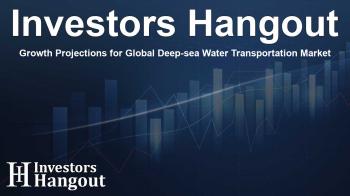Growth Projections for Global Deep-sea Water Transportation Market

Overview of the Deep-sea, Coastal & Inland Water Transportation Market
The deep-sea, coastal, and inland water transportation market is on a remarkable trajectory, with projections indicating a reach of US$ 3,185.46 billion by 2034. This burgeoning sector is expected to grow at an impressive compound annual growth rate (CAGR) of 9.4% between 2024 and 2034, driven by extensive investments in port infrastructure and modernization across the globe.
Investments and Infrastructure Enhancements
Governments and private enterprises are significantly investing in enhancing port facilities, which is essential for accommodating larger vessels and increasing cargo handling efficiency. Modernized ports are crucial for reducing turnaround times, which in turn streamlines the transportation of goods and meets the escalating demands of international trade. Innovations in the deep-sea and inland water transportation sector are simplifying operations, ensuring smoother logistics for commodities.
Technological Advancements in Maritime Transportation
Recent advancements in technology are transforming maritime transport, making it more reliable and efficient. Intelligent shipping systems and autonomous vessels are at the forefront of these changes, with smart technologies enabling real-time monitoring and automation. These innovations serve as key investments for businesses aiming to enhance safety and optimize cargo management throughout the transportation process.
Regional Insights: East Asia's Dominance
East Asia plays a pivotal role in the global transportation landscape. With its extensive marine infrastructure and strong economies such as China, Japan, and South Korea, this region commands a substantial market share in deep-sea, coastal, and inland water transportation. These economies are crucial for global freight movements, significantly impacting overall trade dynamics.
Market Dynamics and Future Trends
As the demand for efficient transportation methods increases, the deep-sea, coastal, and inland water transportation market is evolving. Companies are continually expanding their fleets, focusing on acquiring larger and more fuel-efficient vessels to meet market needs sustainably. This shift is not just about enhancing capacity but also about adhering to environmental commitments, which are becoming increasingly important in maritime operations.
Key Players in the Industry
Several prominent companies are leading the charge in innovation within this sector, including Maersk Line Ltd., MSC Mediterranean Shipping Company Inc., and Carnival Corporation, among others. These players are pivotal in developing new strategies that enhance the efficiency and sustainability of water transportation.
Container Transportation: A Key Segment
Container transportation remains a crucial aspect of global trade, offering cost-effectiveness, flexibility, and efficiency. This service enables the secure and standardized movement of various goods, facilitating seamless transport across different modes such as trucks, trains, and ships. Enhanced supply chains and reduced shipping costs make container transportation an attractive choice for businesses worldwide.
Industry Developments and Regulatory Support
The sector is also witnessing significant developments supported by regulatory frameworks designed to improve port facilities and promote sustainable maritime practices. For instance, recent initiatives launched aim to bolster the operational capabilities of ports, ensuring they are equipped to manage increasing cargo volumes while adhering to eco-friendly standards.
Conclusion: Navigating Future Challenges
As the world looks toward a future marked by increased globalization and trade, the deep-sea, coastal, and inland water transportation market stands ready to adapt and thrive. The investment in modern fleet capabilities, along with ongoing technological advancements, emphasizes the industry's commitment to meeting growing demand efficiently. The continued support from governments and private sectors will shape the evolution of this vital market, ensuring its resilience in facing future challenges.
Frequently Asked Questions
What is the projected market size for deep-sea, coastal, and inland water transportation by 2034?
The market is projected to reach US$ 3,185.46 billion by 2034.
What factors are driving the growth of this transportation market?
Key factors include significant investments in port infrastructure, technological advancements, and the demand for efficient logistics solutions.
Which regions are leading in the deep-sea and inland water transportation market?
East Asia holds a dominant position, significantly influencing global freight transportation due to its strong economies.
How does container transportation benefit global trade?
Container transportation facilitates economical and efficient movement of goods, improving supply chain flexibility and reducing costs.
What role do key players have in shaping this market?
Leading companies drive innovation and expand fleets to enhance operational capacity and sustainability within the industry.
About Investors Hangout
Investors Hangout is a leading online stock forum for financial discussion and learning, offering a wide range of free tools and resources. It draws in traders of all levels, who exchange market knowledge, investigate trading tactics, and keep an eye on industry developments in real time. Featuring financial articles, stock message boards, quotes, charts, company profiles, and live news updates. Through cooperative learning and a wealth of informational resources, it helps users from novices creating their first portfolios to experts honing their techniques. Join Investors Hangout today: https://investorshangout.com/
Disclaimer: The content of this article is solely for general informational purposes only; it does not represent legal, financial, or investment advice. Investors Hangout does not offer financial advice; the author is not a licensed financial advisor. Consult a qualified advisor before making any financial or investment decisions based on this article. The author's interpretation of publicly available data shapes the opinions presented here; as a result, they should not be taken as advice to purchase, sell, or hold any securities mentioned or any other investments. The author does not guarantee the accuracy, completeness, or timeliness of any material, providing it "as is." Information and market conditions may change; past performance is not indicative of future outcomes. If any of the material offered here is inaccurate, please contact us for corrections.
